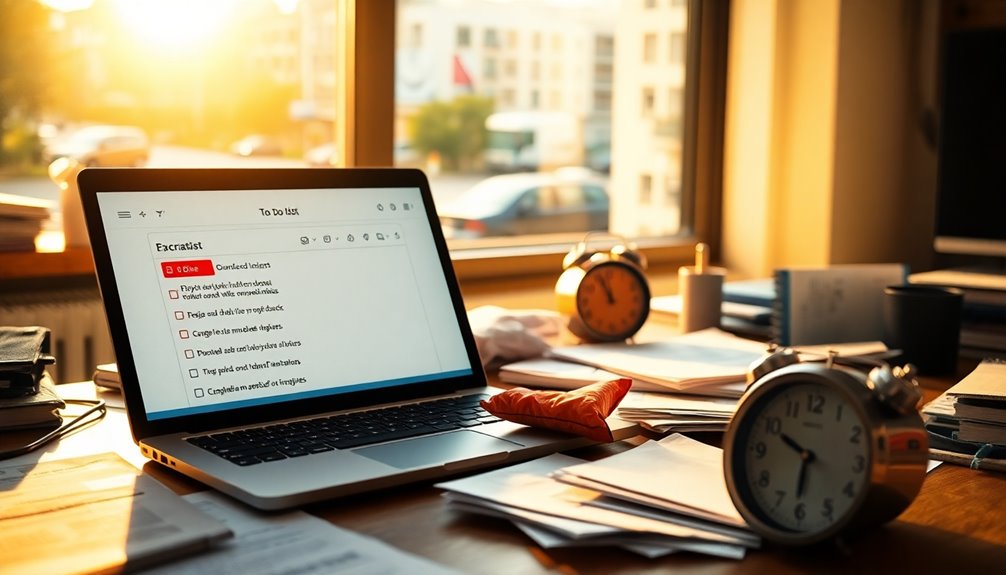Strategic procrastination works when you intentionally delay tasks to boost creativity, incubation, and problem-solving. It’s effective during short or medium delays, especially when tasks benefit from subconscious reflection and flexible deadlines. This approach helps prevent burnout, generate innovative ideas, and improve decision quality. However, it’s important to manage emotional triggers and avoid pitfalls like chronic postponement. If you want to discover how to use delays wisely and avoid common mistakes, keep exploring further.
Key Takeaways
- Strategic procrastination involves delaying tasks to enhance creativity, incubation, and problem-solving capabilities.
- It is most effective during short to medium delays benefiting from diverse information exposure.
- Proper timing helps prevent burnout, improve decision quality, and foster innovative outcomes.
- Using structured breaks and environmental tools can optimize delay benefits while minimizing stress.
- Awareness of psychological triggers and pitfalls ensures delays support productivity rather than hinder it.
Understanding the Concept of Strategic Procrastination

Have you ever considered that delaying a task might actually boost your creativity? That’s the core idea behind strategic procrastination. Instead of rushing to complete something immediately, you deliberately hold back to give your subconscious time to develop new ideas and solutions. It’s about setting clear goals and then stepping away temporarily, not avoiding work but preparing for it smarter. This approach creates a balance between periods of inactivity and bursts of high productivity, helping you reflect and innovate. By doing so, you foster divergent thinking and problem-solving skills. Strategic procrastination isn’t about wasting time; it’s a purposeful tactic to make your next move more creative and effective. It turns delay into a tool for generating original ideas and achieving better results.
The Cognitive and Creative Advantages of Delaying

Delaying a task strategically allows your brain to incubate ideas and process problems more deeply, leading to enhanced creativity and insight. This pause fosters nonlinear and divergent thinking, helping you make unexpected conceptual leaps rather than sticking to rigid patterns. Moderate procrastination activates your prefrontal cortex, supporting complex decision-making after reflection. It also enables subconscious problem-solving, promoting incubation—a recognized phase in creativity that sparks new ideas. During this delay, your mind explores a broader range of associations, increasing the likelihood of innovative solutions. Reflection during postponement deepens your understanding of the task, encouraging novel combinations and insights. When motivated intrinsically, this deliberate delay boosts creativity and problem-solving, while reducing immediate cognitive load and stress, ultimately supporting mental clarity and more effective decision-making.
How Strategic Procrastination Boosts Innovation and Productivity

Strategic procrastination can markedly boost your innovation and productivity by allowing ideas to incubate and evolve before final decisions are made. When you pause intentionally, you create mental space for fresh perspectives and deeper problem-solving, which often leads to more innovative outcomes. This deliberate delay encourages the development of creative thinking by giving your mind time to explore multiple possibilities without pressure. It also fosters divergent thinking, encouraging exploration of multiple ideas and unconventional approaches. Additionally, strategic delays help you recover from intense effort, preventing burnout and maintaining sustainable progress. Managing timing effectively can also be supported by mindfulness practices, which cultivate present-moment awareness and reduce impulsive reactions. Recognizing personality traits that influence procrastination can help tailor strategies to optimize your workflow. Incorporating an understanding of contrast ratio and its impact on perceived clarity can further refine your decision-making process, ensuring that your delayed choices are based on clearer, more detailed information. Furthermore, understanding the Gold IRA Rollovers process can provide additional avenues for strategic financial planning, allowing for delayed yet well-informed investment decisions. By managing timing effectively, you can improve decision quality and generate sharper, more competitive solutions—ultimately boosting your innovation and productivity.
Practical Uses in Professional and Creative Fields

How can intentional pauses enhance your professional and creative workflows? Deliberate delays give you extra time to gather information, refine strategies, and prioritize tasks more effectively. In project management, postponing decisions helps avoid rushing into commitments and reduces risks from incomplete data. Arcade Machines can serve as engaging tools for team-building exercises or stress relief, contributing to a more balanced work environment. For product launches, waiting allows deeper market analysis, leading to better-tailored offerings. In creative fields, delaying start times encourages idea incubation, fostering innovation and higher-quality work. Short breaks from coding or brainstorming refresh your perspective and prevent burnout, while deadlines set after delays motivate higher performance. Techniques like time blocking and the Pomodoro method create structured pauses that sustain focus. Additionally, integrating AI tools can assist in analyzing data and optimizing workflows during these strategic delays. Recognizing the importance of risk assessment helps you avoid potential pitfalls and make more informed decisions. Considering shelf life from storage perspectives, you can better plan your project timelines to ensure freshness and relevance. Furthermore, understanding the performance metrics of your workflow can guide you in adjusting your strategies for maximum efficiency. By intentionally integrating these strategic delays, you can optimize productivity, enhance creativity, and make more informed, confident decisions in your professional and artistic pursuits.
Psychological Insights Behind Choosing to Delay

Choosing to delay tasks often stems from complex psychological motivations that influence your decision-making process. You might delay to temporarily reduce stress, avoiding immediate feelings of overwhelm. Often, you seek mood regulation, hoping future emotional states will be better suited for tackling challenges. Task aversion plays a role too—when tasks seem unpleasant or difficult, you prefer to postpone them in favor of more enjoyable activities. Cognitive distortions, like overestimating available time or waiting for the “right” mood, also contribute. Additionally, avoidance acts as a coping mechanism for anxiety and stress, providing short-term relief. Your brain’s reward system reinforces delaying by seeking immediate pleasure or relief, even though this may impair long-term productivity and well-being. These psychological factors shape your tendency to procrastinate intentionally. Furthermore, understanding the psychological motivations behind procrastination can help you develop strategies to manage and reduce it effectively.
Recognizing When to Practice Strategic Procrastination

Knowing when to practice strategic procrastination can substantially boost your productivity and creativity. Focus on tasks that benefit from incubation, like those requiring creative problem-solving or complex decisions. Projects with flexible deadlines are ideal, as delaying won’t cause immediate issues. When your intrinsic motivation is high, procrastination fuels idea generation and innovation; if motivation is low, it’s best to avoid delay. Short to medium delays are most effective, giving your subconscious time without causing stress. Look for opportunities during interruptions or exposure to diverse information to spark new insights. Favor environments that value autonomy and flexibility, and monitor timing carefully to prevent last-minute rushes. Recognizing these cues helps you strategically delay tasks, transforming procrastination into a tool for enhanced creativity and productivity. Incorporating data-driven marketing strategies can also optimize your approach and make your delayed efforts more impactful. Additionally, aligning your decluttering practices with your workflow can create a more organized environment that supports focused work during these delays. Staying informed about industry trends, such as the rise of WWE Raw’s financial impact, can inspire innovative ideas during incubation periods. Paying attention to nutritional benefits of juices and related topics can also inspire innovative ideas or fresh perspectives during your incubation periods, enriching your overall productivity.
Common Pitfalls and How to Avoid Them

Procrastination often seems harmless at first, but it can lead to serious emotional and psychological consequences that undermine your well-being. Chronic procrastination raises stress levels, which can cause insomnia, digestive issues, and muscle tension. It’s linked to increased depression and anxiety, reducing your self-compassion. Emotional regulation failures during delays only intensify stress, creating a vicious cycle. You might use procrastination as self-handicapping, blaming time constraints instead of ability, harming your motivation and self-identity. Poor time management, like overestimating your available time or avoiding breaking tasks into smaller steps, worsens the problem. Additionally, procrastination can strain social and work relationships, leading to resentment and decreased trust. Recognizing these pitfalls helps you develop healthier habits and avoid falling into these destructive patterns. Being mindful of your environment and choosing suitable camping gear can also help improve your focus and reduce delays in completing tasks. Incorporating effective tools such as vacuums, especially those designed for specific needs like pet hair or delicate flooring, can contribute to a more organized and efficient workspace, reducing the tendency to delay. Developing awareness of emotional regulation strategies and understanding mental clarity and health can further help in managing stress and maintaining motivation during challenging periods. Additionally, maintaining a clutter-free workspace with appropriate home organization tools can support your efforts to stay on track and complete tasks more efficiently.
Tips for Implementing Effective Delays in Your Workflow

Implementing effective delays in your workflow requires strategic planning to guarantee they serve as productive pauses rather than unproductive stalls. Break large tasks into manageable segments, focusing on one small step at a time to reduce overwhelm and build momentum. Set clear, specific goals with concrete deadlines, and write them down where you’ll see them daily to stay focused. Use structured time management techniques like the Pomodoro Method—work in focused intervals with regular breaks—to maintain concentration and prevent burnout. Incorporate strategic task switching between demanding and easier tasks to sustain motivation and avoid mental fatigue. Finally, optimize your environment with motivating music and minimal distractions, and use accountability tools to reinforce your commitment to delayed tasks. These strategies help you delay intentionally and productively.
Frequently Asked Questions
How Can I Distinguish Between Strategic Procrastination and Harmful Delay?
You can tell the difference by noticing your mindset and emotional state. If you delay intentionally, based on careful thought, confidence in long-term benefits, and minimal stress, you’re engaging in strategic procrastination. But if you feel anxious, avoidant, or the delay causes missed deadlines and increased stress, it’s harmful delay. Strategic procrastination is purposeful and rational, while harmful delay is impulsive, irrational, and often leads to negative outcomes.
What Are Signs That I Am Overusing Procrastination Effectively?
Imagine your procrastination as a garden. If it’s thriving, you feel relaxed and productive, balancing tasks without stress. You notice no weeds of anxiety or frustration taking over. Your self-control remains steady, and your routines stay in bloom. When you’re overusing it, the garden becomes overgrown, choking out joy and progress. Stress, missed deadlines, and low self-esteem are the weeds signaling your garden needs tending, not neglect.
How Does Strategic Procrastination Impact Team Dynamics and Collaboration?
You notice that delaying tasks can influence how your team works together. If members habitually postpone tasks, it creates norms that accept delays, undermining trust and cooperation. Over time, productivity drops, deadlines are missed, and tension rises. If you manage procrastination well, you can strengthen collaboration and trust. But if it’s unchecked, it weakens team bonds, hampers performance, and erodes morale, making it harder to achieve shared goals.
Are There Specific Tasks or Projects Best Suited for Delayed Decision-Making?
You might think delaying decisions hampers progress, but certain tasks actually benefit from it. High-stakes projects, creative endeavors, and complex problems need extra time for thorough planning, idea development, and gathering insights. By strategically delaying, you give yourself space to contemplate options carefully, avoid rushed choices, and improve outcomes. This approach helps make certain your decisions are well-informed, ultimately leading to better results and more innovative solutions.
How Can I Develop Self-Discipline to Practice Intentional Procrastination?
To develop self-discipline for intentional procrastination, start by setting clear, SMART goals and breaking projects into manageable steps. Create a structured routine with focused work periods and designated rest times. Practice mindfulness to manage emotions and build self-control, resisting impulsive urges. Share your goals for accountability, track progress, and reward achievements. These practices help you delay strategically, staying motivated and balanced while maintaining control over your work.
Conclusion
Think of strategic procrastination as tending to a garden—you delay just enough to let ideas marinate and grow stronger. When you master this approach, you’ll find your creativity blossoms and your productivity blooms. By knowing when to pause and reflect, you’re cultivating a fertile ground for innovation. So, embrace the art of intentional delay, and watch your work flourish like a well-tended garden, thriving with fresh, inspired ideas.









